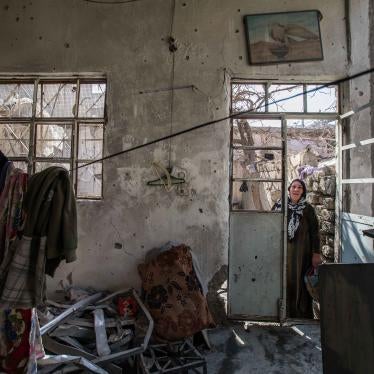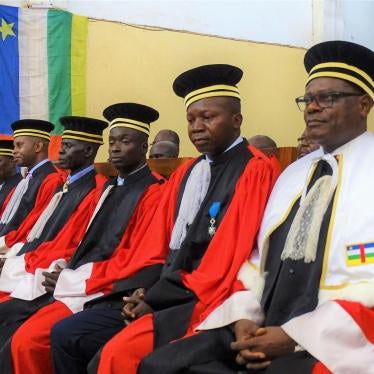The world is finally starting to pay attention to the tragedy unfolding in the Central African Republic, a landlocked country of 4.6 million people in the heart of Africa, and one of the most impoverished places on Earth. With hundreds of people killed in the capital city Bangui last week, and the conflict taking a dangerous sectarian turn, the handling of the CAR crisis will certainly become a test case for R2P advocates.
This time, the UN has not been short on warnings. “We have an opportunity, and the responsibility, to prevent what could become widespread atrocities,” warned UN Secretary-General Ban Ki-moon in a recent report to the Security Council. Following a trip to the country, John Ging, the UN’s operations director for the Office for the Coordination of Humanitarian Affairs, said on November 13th he was “very concerned that the seeds of genocide are being sown.”
R2P was developed to address such explosive situations before it is too late. And yet, strikingly, in discussing the Central African Republic, advocates of greater international involvement and most policy makers shy away from invoking R2P. Even the French government, which justified its military intervention in Libya or Ivory Coast in R2P terms, is staying clear of invoking the norm.
Is this a sign that R2P is losing its relevance? Has the norm become so controversial as to become unusable? There is no question that NATO’s intervention in Libya -- by stretching to the limits what was permissible under an R2P framework -- did lasting damage. Similarly, the abysmal failure of the international community to address the mass killing of Syrian civilians begs the question – if R2P does nothing for Syrians, what good is it?
Yet, predicting a demise of R2P on this basis would miss a crucial element Although not explicitly invoked, the ideas underlying R2P are implicitly infusing much of the current thinking on how to avert the worst in the Central African Republic; a sign perhaps that far from being irrelevant, R2P has gone mainstream. The wider acceptance of R2P in fact helps explain why a forgotten country, with neither natural resources nor any real strategic interest, is slowly earning a spot at the center of the world’s attention.
The current crisis started in March, when predominantly Muslim armed groups from the north, called the Seleka (“alliance”), staged a violent offensive, ousting president François Bozizé from power, and installing in the capital city Bangui one of its leaders, Michel Djotodia – the first Muslim president of this majority-Christian nation.
With no discernible political or religious agenda, and as documented in our September report “I Can Still Smell the Dead:” The Forgotten Human Rights Crisis in the Central African Republic , the Seleka have raped, pillaged and burned, killing scores of women, children and elderly. While Muslim communities were not always spared, the Seleka have been particularly vicious toward Christian civilians.
Seleka abuses contributed to the resurgence of mostly Christian militias known as the “anti-balaka”(“anti-machete”), comprising poorly armed civilians backed by a few former military personnel still loyal to Bozizé. While they claim to protect their villages against Seleka attacks, many have retaliated against defenseless Muslim civilians with the same cruelty and brutality.
During a research mission in northern Central African Republic last month, I talked to Massadou Bichefou, a Muslim herder, age 55, who told me he had hidden in tall grass while an anti-balaka man armed with a knife slit the throat of each of his 11 children and grandchildren and then his two wives. In a village called Votovo, survivors described to me how several dozen anti-balaka men arrived in late September and forced all the Muslims out of their houses, separating the men and boys from the women and younger kids, while shouting that they would “exterminate all the Muslims.” They slit the throat of one of the men, and shot three more people, including a 13-year-old boy, before the other male residents escaped. Survivors told me that when the remaining men came back after nightfall, 21 women and children were missing. Their houses were burned, and only the heads of their dead cattle were left on the ground.
This cycle of violence has already claimed many lives, but as bad as they are, things could get much worse.
In a country on the brink of anarchy, where the few remaining state institutions have been taken over by men installed in power through force, and whose fighters are implicated in serious abuses, R2P’s primary reliance on the state to protect its own civilians means little. What, then, is the international community to do?
For now, the plan is to deploy a force of 6,000 troops under the umbrella of the African Union- sanctioned mission (MISCA), which is authorized to take all necessary measures to protect civilians, under UN Security Council resolution 2127, unanimously adopted on December 5. The resolution also tasks the French troops now in the country to assist MISCA.
MISCA is scheduled to take over for and incorporate 2,600 poorly equipped troops who are already on the ground as part of a regional peacekeeping mission called MICOPAX, sponsored by the Economic Community of Central African States. While the deployment of MICOPAX was aimed at securing Bangui and preventing the worst violence, the peacekeepers are not up to the challenges now facing the country.
While on the ground, we rarely saw them patrol insecure roads or near vulnerable communities. In Bossangoa, in the North, even if at times they showed great courage under fire, we also saw them being pushed around by Seleka fighters in flip flops, and selling beer or providing private security to businesses to make extra money. Of course, until a better force can be deployed, these regional mechanisms need all the support they can get, including with equipment, logistics and financing. The US has already committed 40 million USD and logistical assistance, and the EU has pledged “significant financial assistance.”
The French, realizing that MISCA can’t do the job, have already bumped up their presence from 1,200 to 1,600 soldiers. They might be persuaded to do more. While this will definitely help MISCA improve its efforts to protect civilians, it’s a short-term solution to a long-term issue.
In the longer term, a force of 6,000 to 9,000 UN blue helmets, as proposed by Ban Ki-moon, and deployed with a strong mandate to protect civilians, would help bring back a measure of security in the country. It would allow tens of thousands of people – who now live in fear in unsanitary camps, or deep in the bush where malaria is rampant – to go back home and rebuild their lives. Such a mission would also come with the civilian expertise necessary to rebuild the state administration and justice mechanisms, as well as help support elections and conduct human rights monitoring.
Deploying such a mission takes time, at least six months, so Security Council members should waste no time in authorizing it. So far, the US has been reluctant to authorize another costly UN mission. With CAR presenting little strategic interest to Council members, other than the potential of regional destabilization caused by another failed state, there has been little pressure to act. But the absence of perceived hidden agendas could make this a “purer” form of R2P intervention.
The language of responsibility of states to protect their citizens has become commonplace in Security Council statements. But when states fail to meet their responsibility R2P language has rarely been turned into R2P action. And as President Obama said, “preventing mass atrocities and genocide is a core national security interest and a core moral responsibility of the United States.”
Early warning has worked in CAR; the international community has awakened to this “forgotten crisis.” What remains is the responsibility to protect the country’s terrorized civilians.









